Technology
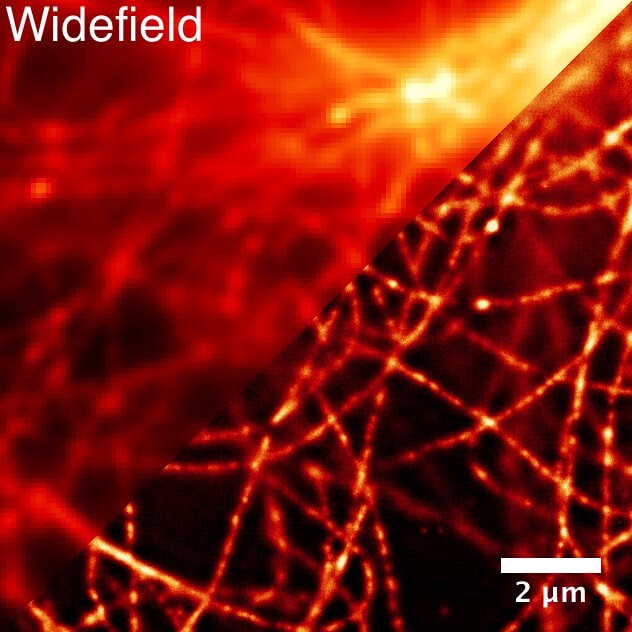
NanoJ-SRRF
GitHub:
- HenriquesLab/NanoJ-SRRF
Publication: Gustafsson et al. Nature Communications 2016
- 582
Super-resolution radial fluctuations (SRRF) is an analytical approach for super-resolution microscopy that enables high-resolution imaging of both fixed and live cells using conventional fluorophores. Here is a 1000 word explanation of what SRRF is and how it works:
SRRF is an algorithm that performs temporal analysis on a sequence of fluorescence microscopy images to generate a super-resolution reconstruction without requiring localization of individual fluorophores. The key principles behind SRRF are:
1) It assumes the image is formed of point light sources (fluorophores) convolved with the point spread function (PSF) of the microscope.
2) It calculates a "radiality" map for each frame that measures the degree of local symmetry rather than intensity. This results in a narrow distribution centered on each fluorophore's position that is independent of brightness.
3) Noise peaks are filtered out by weighting the radiality map based on intensity and local gradients. This preserves true fluorophore peaks while suppressing noise.
4) Temporal analysis correlates radiality maps over time. This further suppresses noise which is uncorrelated between frames while enhancing the radiality signal at fluorophore positions which is correlated over time.
In more detail:
The algorithm first calculates a "radiality" map for every frame. For each pixel, it measures gradient convergence from surrounding pixels within a defined radius. Where the gradients point inwards towards a central point, there is high radiality. This gives a radiality peak over each fluorophore, analogous to the point spread function (PSF) but with much narrower width.
Crucially, radiality peak width and amplitude is independent of brightness, depending only on the degree of local symmetry. Dim fluorophores give radiality peaks comparable to bright ones. This provides inherent robustness to intensity fluctuations from blinking/blurred fluorophores.
The raw radiality map contains noise peaks from random gradient alignments. To reduce this noise, the radiality map is weighted by (a) the intensity image to selectively enhance radiality at bright regions and (b) the gradient magnitude image to selectively enhance radiality where gradients are stronger (i.e. in focus).
This provides a "de-noised" radiality map for each frame. However, noise peaks may still occur randomly over time while peaks from actual fluorophores remain at fixed positions over multiple frames.
Temporal analysis exploits this by calculating the temporal correlation or higher order cumulants between radiality maps over time. Due to the uncorrelated nature of noise peaks in time, temporal correlation emphasizes actual fluorophore positions while suppressing noise peaks.
In effect, SRRF transforms a sequence of diffraction limited images into narrow "radiality peaks" for each fluorophore. It then uses temporal correlation to filter out noise peaks while retaining peaks due to real fluorophores. The final SRRF image has resolution enhanced to the average width of these narrow radiality peaks.
As radiality is calculated from the PSF via gradients rather than intensity, SRRF maintains robust performance across varying fluorophore densities. At low densities, it approaches precision comparable to single molecule localization. At ultra-high densities beyond localization limits, it can still resolve features down to ~100-150 nm resolution.
This density robustness combined with low illumination requirements allows live cell super-resolution imaging over extended periods without excessive phototoxicity. By analyzing as few as 100 frames, SRRF can generate 1 super-resolution frame per second. This enables studying nanoscale dynamics in living cells.
SRRF is unique in using a temporal radiality analysis approach to deliver live cell super-resolution movies across varying fluorophore densities. It pushes super-resolution into a simple and accessible implementation on conventional microscopes. The algorithm is provided as an open-source ImageJ/Fiji plugin, helping adoption across the biological sciences community.
Publications featuring NanoJ-SRRF

|
Expansion and fluctuations-enhanced microscopy for nanoscale molecular profiling of cells and tissues Dominik Kylies, Hannah S. Heil, Arturo G. Vesga, Mario Del Rosario, Maria Schwerk, Malte Kuehl, Milagros N. Wong, Victor G. Puelles, Ricardo Henriques Paper published in Nature Protocols, July 2025 Technologies: NanoJ (), NanoJ-eSRRF (), NanoJ-SQUIRREL (), NanoJ-SRRF (), NanoPyx () and Nuclear-Pores as references Funded by: CZI, EMBO, ERC, FCT, H2021 and H2022 DOI: 10.1038/s41596-025-01178-0 |
|
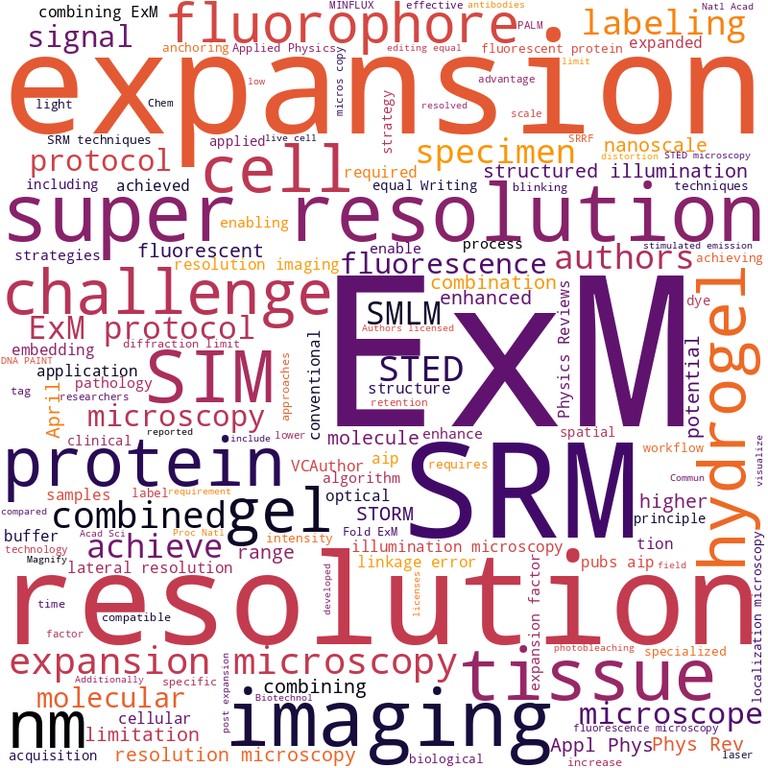
|
Nanoscale imaging of biological systems via expansion and super-resolution microscopy Daria Aristova, Dominik Kylies, Mario Del Rosario, Hannah S. Heil, Maria Schwerk, Malte Kuehl, Milagros N. Wong, Ricardo Henriques, Victor G. Puelles Paper published in Applied Physics Reviews, April 2025 Technologies: NanoJ-eSRRF () and NanoJ-SRRF () Funded by: CZI, EMBO, ERC, FCT, H2021 and H2022 DOI: 10.1063/5.0240464 |
|
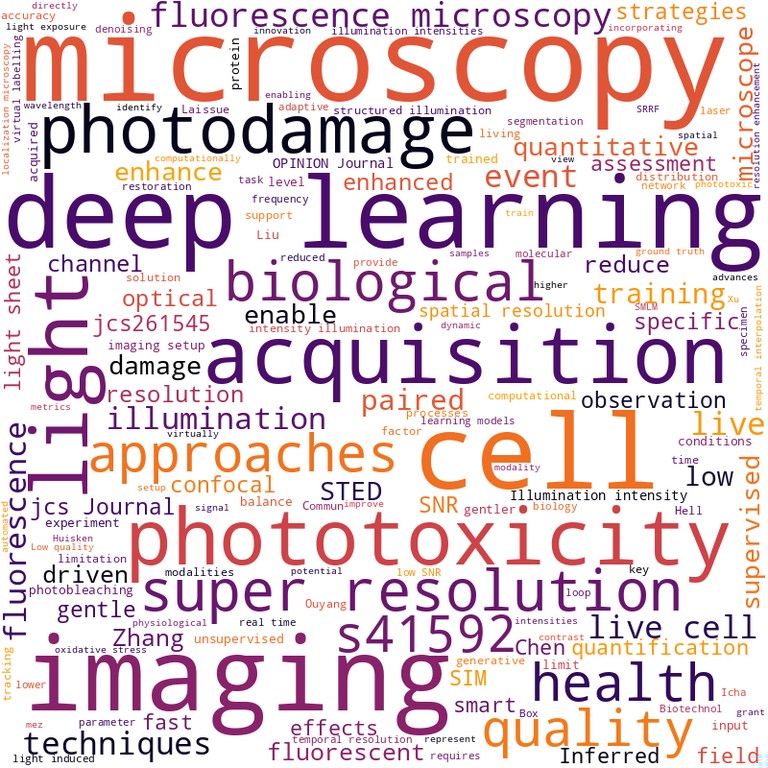
|
Harnessing artificial intelligence to reduce phototoxicity in live imaging Estibaliz Gómez-de-Mariscal, Mario Del Rosario, Joanna W. Pylvänäinen, Guillaume Jacquemet, Ricardo Henriques Perspective published in Journal of Cell Science, February 2024 Technologies: BioImage Model Zoo (), CARE (), DeepBacs (), NanoJ-eSRRF (), NanoJ-SQUIRREL (), NanoJ-SRRF () and ZeroCostDL4Mic () Funded by: CZI, EMBO, ERC, H2021 and H2022 DOI: 10.1242/jcs.261545 |
|
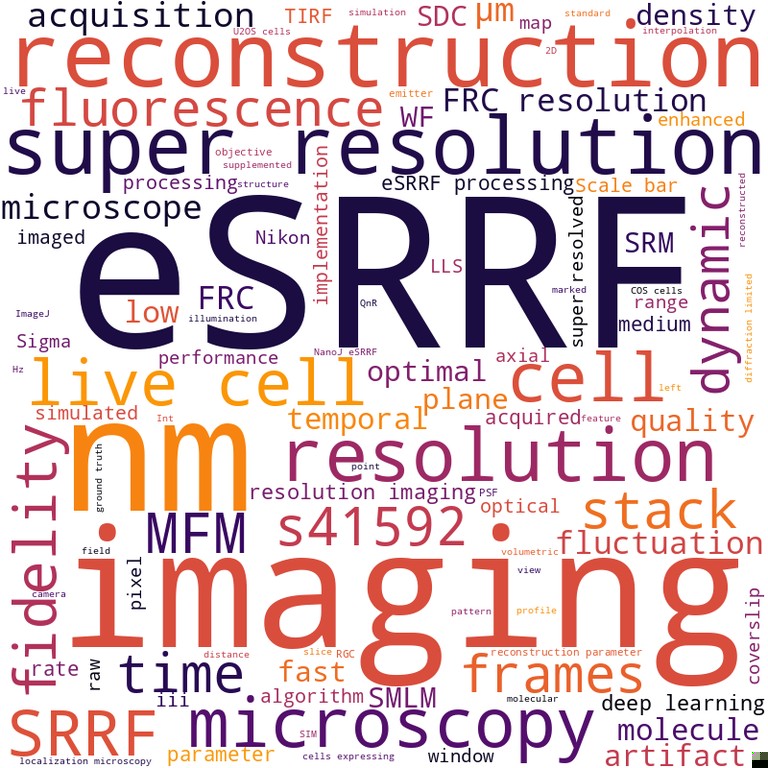
|
High-fidelity 3D live-cell nanoscopy through data-driven enhanced super-resolution radial fluctuation Romain F. Laine, Hannah S. Heil, Simao Coelho, Jonathon Nixon-Abell, Angélique Jimenez, Theresa Wiesner, Damián Martínez, Tommaso Galgani, Louise Régnier, Aki Stubb, Gautier Follain, Samantha Webster, Jesse Goyette, Aurelien Dauphin, Audrey Salles, Siân Culley, Guillaume Jacquemet, Bassam Hajj, Christophe Leterrier, Ricardo Henriques Paper published in Nature Methods, November 2023 Technologies: CARE (), NanoJ (), NanoJ-eSRRF (), NanoJ-SQUIRREL (), NanoJ-SRRF () and Nuclear-Pores as references Funded by: CZI, EMBO, ERC, FCT, H2021, H2022, InnOValley and Wellcome Trust News: Photonics.com, The Science Times, Optics.org and Phys.org Blogs: Springer Nature Protocols and Methods Community DOI: 10.1038/s41592-023-02057-w |
|
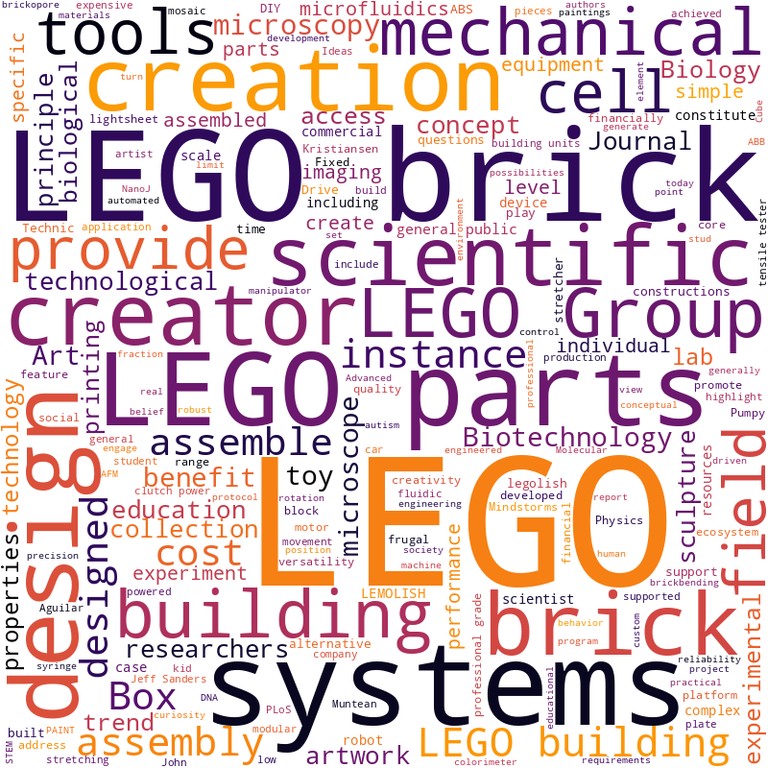
|
The LEGO® brick road to open science and biotechnology Etienne Boulter, Julien Colombelli, Ricardo Henriques, Chloé C. Féral Review published in Trends in Biotechnology, March 2022 Technologies: NanoJ (), NanoJ-Fluidics () and NanoJ-SRRF () Funded by: EMBO, ERC and Wellcome Trust DOI: 10.1016/j.tibtech.2022.02.003 |
|
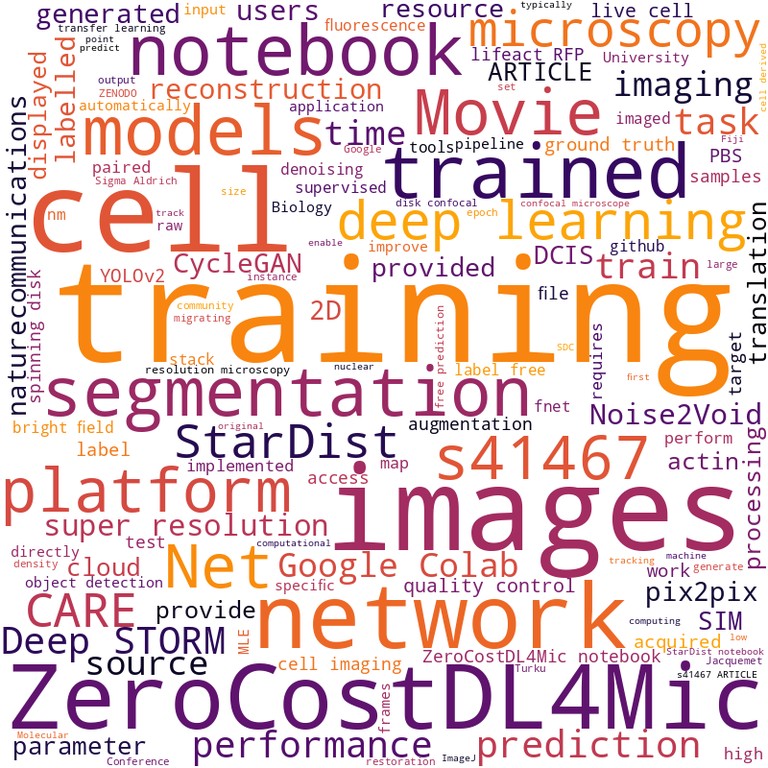
|
Democratising deep learning for microscopy with ZeroCostDL4Mic Lucas von Chamier, Romain F. Laine, Johanna Jukkala, Christoph Spahn, Daniel Krentzel, Elias Nehme, Martina Lerche, Sara Hernández-Pérez, Pieta K. Mattila, Eleni Karinou, Séamus Holden, Ahmet Can Solak, Alexander Krull, Tim-Oliver Buchholz, Martin L. Jones, Loïc A. Royer, Christophe Leterrier, Yoav Shechtman, Florian Jug, Mike Heilemann, Guillaume Jacquemet, Ricardo Henriques Paper published in Nature Communications, April 2021 Technologies: CARE (), NanoJ (), NanoJ-SQUIRREL (), NanoJ-SRRF () and ZeroCostDL4Mic () Funded by: EMBO, ERC and Wellcome Trust News: AZO Life Sciences, Drug Target Review, Nanotechnology Now and The Medical News Blogs: Microbiome Digest - Bik's Picks DOI: 10.1038/s41467-021-22518-0 |
|
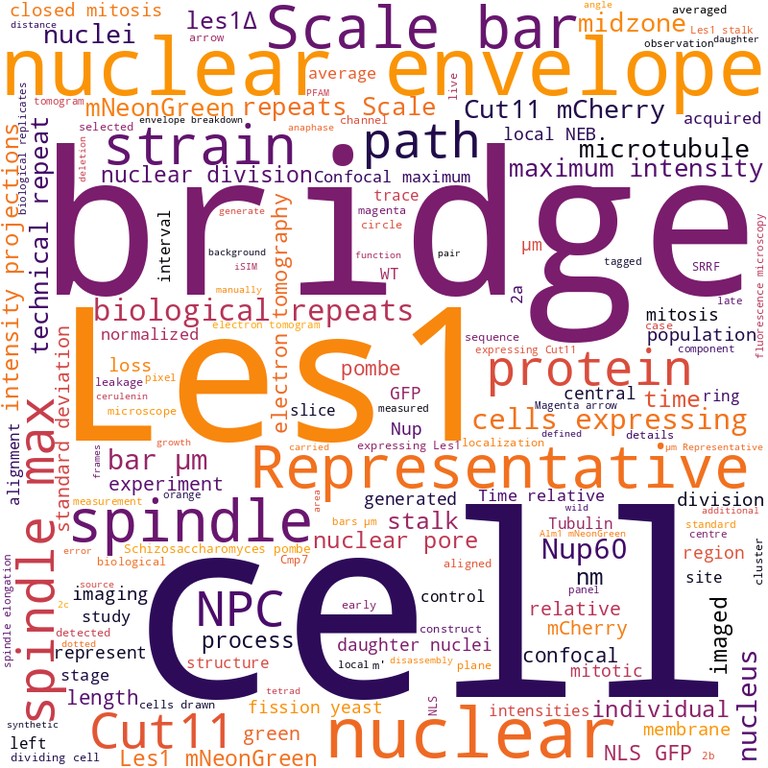
|
Closed mitosis requires local disassembly of the nuclear envelope Gautam Dey, Siân Culley, Scott Curran, Uwe Schmidt, Ricardo Henriques, Wanda Kukulski, Buzz Baum Paper published in Nature, August 2020 Technologies: CARE (), NanoJ (), NanoJ-SRRF () and Nuclear-Pores as references Funded by: BBSRC and Wellcome Trust News: Nature Asia DOI: 10.1038/s41586-020-2648-3 |
|
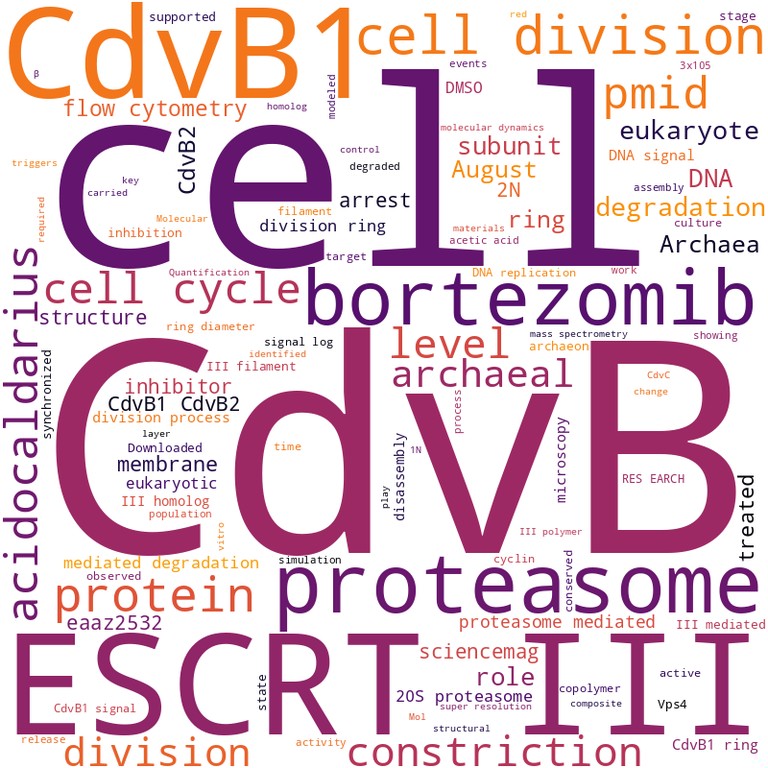
|
The proteasome controls ESCRT-III–mediated cell division in an archaeon Gabriel Tarrason Risa, Fredrik Hurtig, Sian Bray, Anne E. Hafner, Lena Harker-Kirschneck, Peter Faull, Colin Davis, Dimitra Papatziamou, Delyan R. Mutavchiev, Catherine Fan, Leticia Meneguello, Andre Arashiro Pulschen, Gautam Dey, Siân Culley, Mairi Kilkenny, Diorge P. Souza, Luca Pellegrini, Robertus A. M. de Bruin, Ricardo Henriques, Ambrosius P. Snijders, Anđela Šarić, Ann-Christin Lindås, Nicholas P. Robinson, Buzz Baum Paper published in Science, August 2020 Technologies: NanoJ () and NanoJ-SRRF () News: NRK, Scitech Daily, NCYT - Noticias de la Ciencia y la Technologia and UPI.com DOI: 10.1126/science.aaz2532 |
|

|
The cell biologist's guide to super-resolution microscopy Guillaume Jacquemet, Alexandre F. Carisey, Hellyeh Hamidi, Ricardo Henriques, Christophe Leterrier Review published in Journal of Cell Science, June 2020 Technologies: CARE (), NanoJ (), NanoJ-Fluidics (), NanoJ-SRRF () and Nuclear-Pores as references Funded by: BBSRC and Wellcome Trust News: ScienMag and EurekAlert! DOI: 10.1242/jcs.240713 |
|

|
Between life and death - strategies to reduce phototoxicity in super-resolution microscopy Kalina L Tosheva, Yue Yuan, Pedro Matos Pereira, Siân Culley, Ricardo Henriques Review published in Journal of Physics D - Applied Physics, January 2020 Technologies: CARE (), NanoJ (), NanoJ-Fluidics () and NanoJ-SRRF () Funded by: BBSRC and Wellcome Trust DOI: 10.1088/1361-6463/ab6b95 |
|
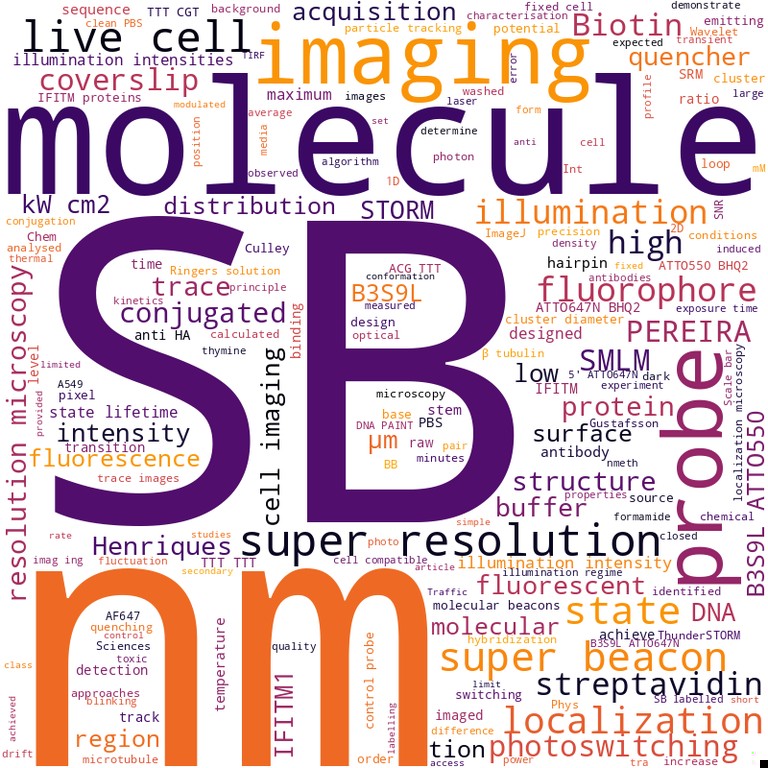
|
Super‐beacons - Open‐source probes with spontaneous tuneable blinking compatible with live‐cell super‐resolution microscopy Pedro M Pereira, Nils Gustafsson, Mark Marsh, Musa M Mhlanga, Ricardo Henriques Paper published in Traffic, January 2020 Technologies: NanoJ (), NanoJ-Fluidics (), NanoJ-SQUIRREL (), NanoJ-SRRF () and Super-Beacons Funded by: BBSRC and Wellcome Trust DOI: 10.1111/tra.12728 |
|
__wordcloud.jpg)
|
Fluctuation-based super-resolution traction force microscopy Aki Stubb, Romain F Laine, Mitro Miihkinen, Hellyeh Hamidi, Camilo Guzmán, Ricardo Henriques, Guillaume Jacquemet, Johanna Ivaska Paper published in Nano letters, January 2020 Technologies: FBSR-TFM, NanoJ (), NanoJ-SQUIRREL () and NanoJ-SRRF () Funded by: BBSRC DOI: 10.1021/acs.nanolett.9b04083 |
|
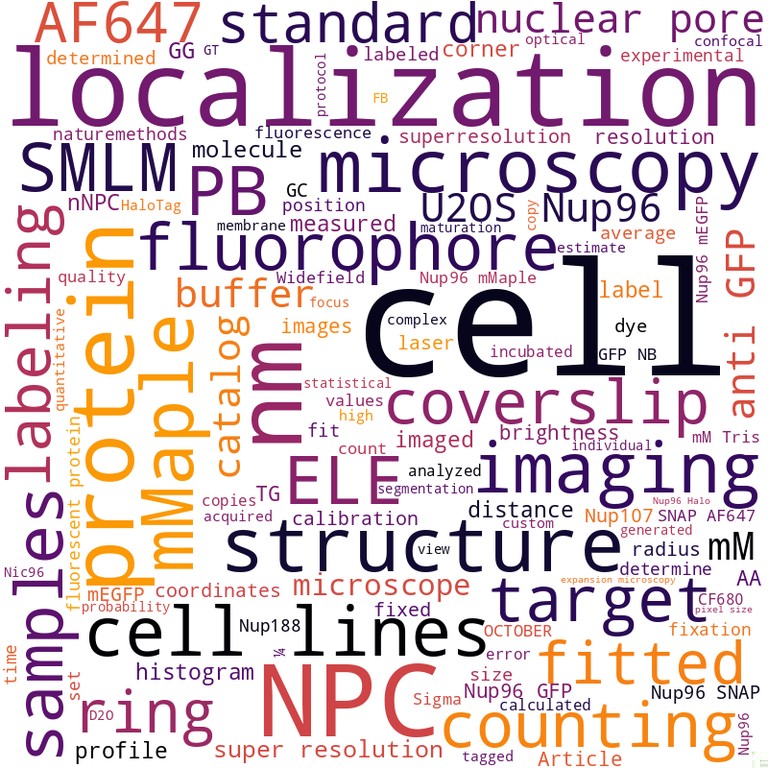
|
Nuclear pores as versatile reference standards for quantitative superresolution microscopy Jervis Vermal Thevathasan, Maurice Kahnwald, Konstanty Cieśliński, Philipp Hoess, Sudheer Kumar Peneti, Manuel Reitberger, Daniel Heid, Krishna Chaitanya Kasuba, Sarah Janice Hoerner, Yiming Li, Yu-Le Wu, Markus Mund, Ulf Matti, Pedro Matos Pereira, Ricardo Henriques, Bianca Nijmeijer, Moritz Kueblbeck, Vilma Jimenez Sabinina, Jan Ellenberg, Jonas Ries Paper published in Nature Methods, September 2019 Technologies: CARE (), NanoJ (), NanoJ-SQUIRREL (), NanoJ-SRRF () and Nuclear-Pores as references Funded by: BBSRC and Wellcome Trust News: Mirage News DOI: 10.1038/s41592-019-0574-9 |
|

|
Artificial intelligence for microscopy - what you should know Lucas von Chamier, Romain F. Laine, Ricardo Henriques Review published in Biochemical Society Transactions, July 2019 Technologies: CARE (), NanoJ (), NanoJ-Fluidics (), NanoJ-SQUIRREL () and NanoJ-SRRF () Funded by: BBSRC and Wellcome Trust News: Azooptics.com DOI: 10.1042/bst20180391 |
|

|
Automating multimodal microscopy with NanoJ-Fluidics Pedro Almada, Pedro M. Pereira, Siân Culley, Ghislaine Caillol, Fanny Boroni-Rueda, Christina L. Dix, Guillaume Charras, Buzz Baum, Romain F. Laine, Christophe Leterrier, Ricardo Henriques Paper published in Nature Communications, March 2019 Technologies: NanoJ (), NanoJ-Fluidics (), NanoJ-SQUIRREL (), NanoJ-SRRF () and NanoJ-VirusMapper Funded by: BBSRC and Wellcome Trust News: Technology Times, MSN, DNYUZ and Express Informer DOI: 10.1038/s41467-019-09231-9 |
|

|
NanoJ - a high-performance open-source super-resolution microscopy toolbox Romain F Laine, Kalina L Tosheva, Nils Gustafsson, Robert D M Gray, Pedro Almada, David Albrecht, Gabriel T Risa, Fredrik Hurtig, Ann-Christin Lindås, Buzz Baum, Jason Mercer, Christophe Leterrier, Pedro M Pereira, Siân Culley, Ricardo Henriques Paper published in Journal of Physics D - Applied Physics, January 2019 Technologies: CARE (), NanoJ (), NanoJ-SQUIRREL (), NanoJ-SRRF (), NanoJ-VirusMapper and QuickPALM Funded by: BBSRC and Wellcome Trust DOI: 10.1088/1361-6463/ab0261 |
|
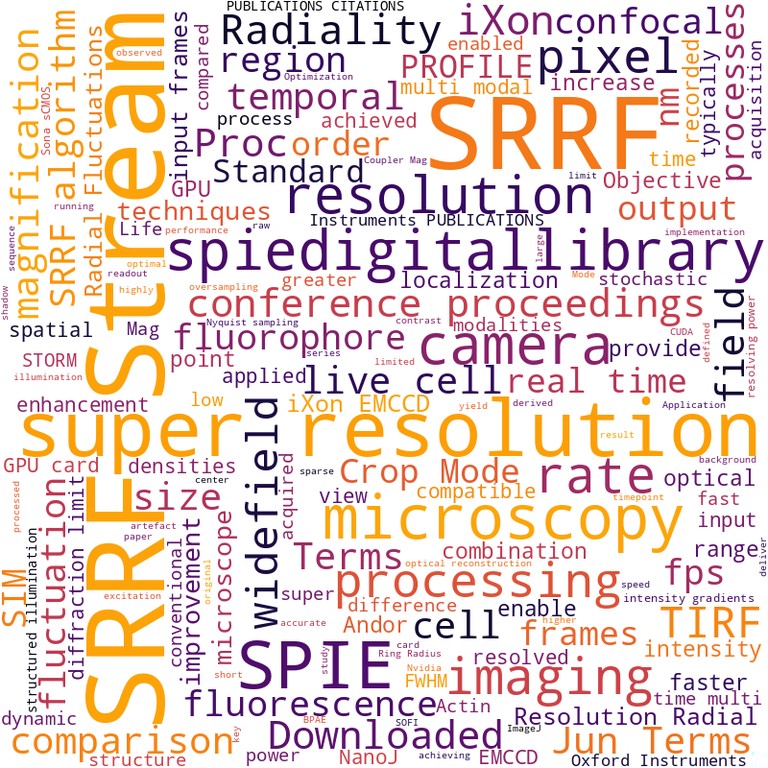
|
Real time multi-modal super-resolution microscopy through Super-Resolution Radial Fluctuations (SRRF-Stream) Justin Cooper, Mark Browne, Hugh Gribben, Martin Catney, Colin Coates, Alan Mullan, Geraint Wilde, Ricardo Henriques Paper published in Single molecule spectroscopy and superresolution imaging XII, January 2019 Technologies: NanoJ-SRRF () DOI: 10.1117/12.2510761 |
|
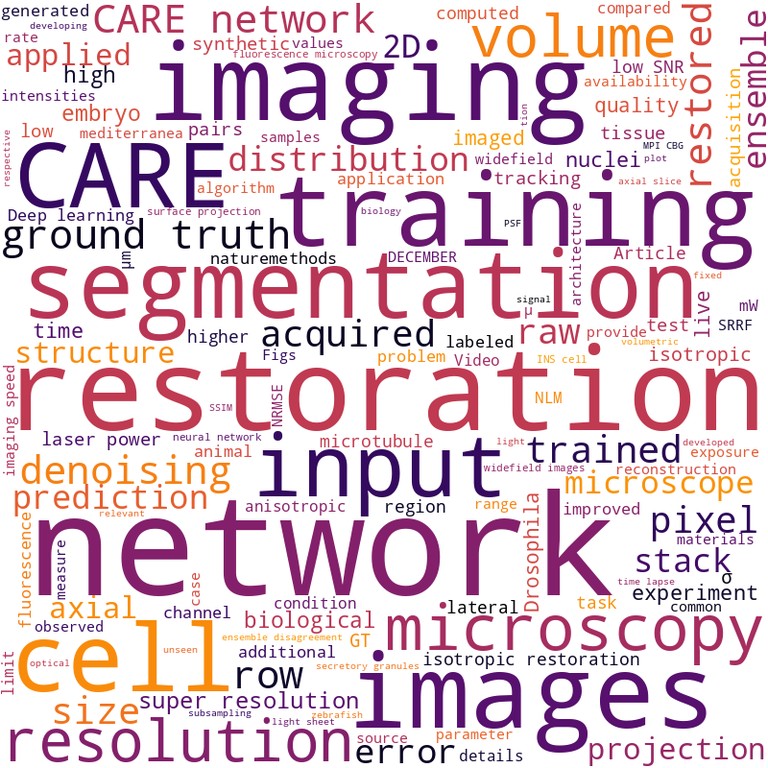
|
Content-aware image restoration - pushing the limits of fluorescence microscopy Martin Weigert, Uwe Schmidt, Tobias Boothe, Andreas Müller, Alexandr Dibrov, Akanksha Jain, Benjamin Wilhelm, Deborah Schmidt, Coleman Broaddus, Siân Culley, Mauricio Rocha-Martins, Fabián Segovia-Miranda, Caren Norden, Ricardo Henriques, Marino Zerial, Michele Solimena, Jochen Rink, Pavel Tomancak, Loic Royer, Florian Jug, Eugene W. Myers Paper published in Nature Methods, November 2018 Technologies: CARE (), NanoJ-SQUIRREL () and NanoJ-SRRF () Funded by: BBSRC and Wellcome Trust News: Technology Networks, VBIO, Innovations Report and Informationsdienst Wissenschaft DOI: 10.1038/s41592-018-0216-7 |
|

|
Heterogeneous localisation of membrane proteins in Staphylococcus aureus Felix Weihs, Katarzyna Wacnik, Robert D. Turner, Siân Culley, Ricardo Henriques, Simon J. Foster Paper published in Scientific Reports, February 2018 Technologies: NanoJ-SRRF () Funded by: BBSRC and Wellcome Trust DOI: 10.1038/s41598-018-21750-x |
|
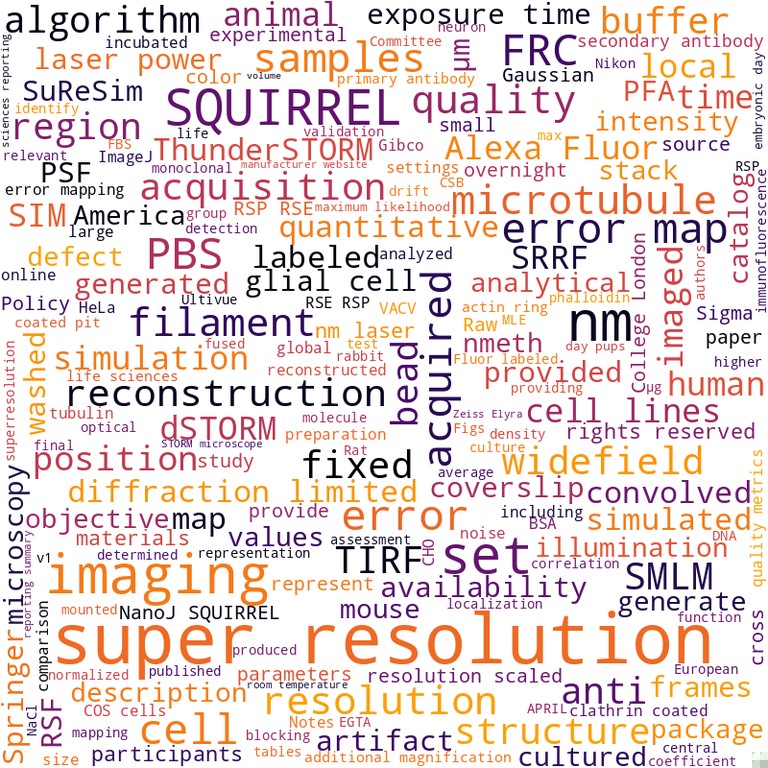
|
Quantitative mapping and minimization of super-resolution optical imaging artifacts Siân Culley, David Albrecht, Caron Jacobs, Pedro Matos Pereira, Christophe Leterrier, Jason Mercer, Ricardo Henriques Paper published in Nature Methods, February 2018 Technologies: NanoJ-SQUIRREL (), NanoJ-SRRF () and QuickPALM Funded by: BBSRC and Wellcome Trust News: physicsworld.com DOI: 10.1038/nmeth.4605 |
|
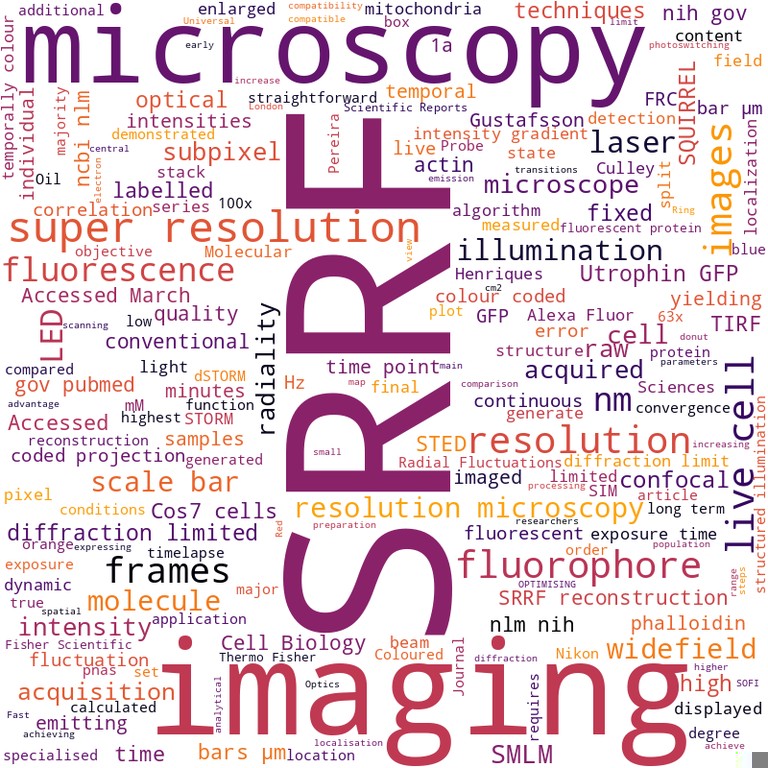
|
SRRF - Universal live-cell super-resolution microscopy Siân Culley, Kalina L Tosheva, Pedro Matos Pereira, Ricardo Henriques Paper published in The international journal of biochemistry & cell biology, January 2018 Technologies: NanoJ-SQUIRREL () and NanoJ-SRRF () Funded by: BBSRC and Wellcome Trust DOI: 10.1016/j.biocel.2018.05.014 |
|
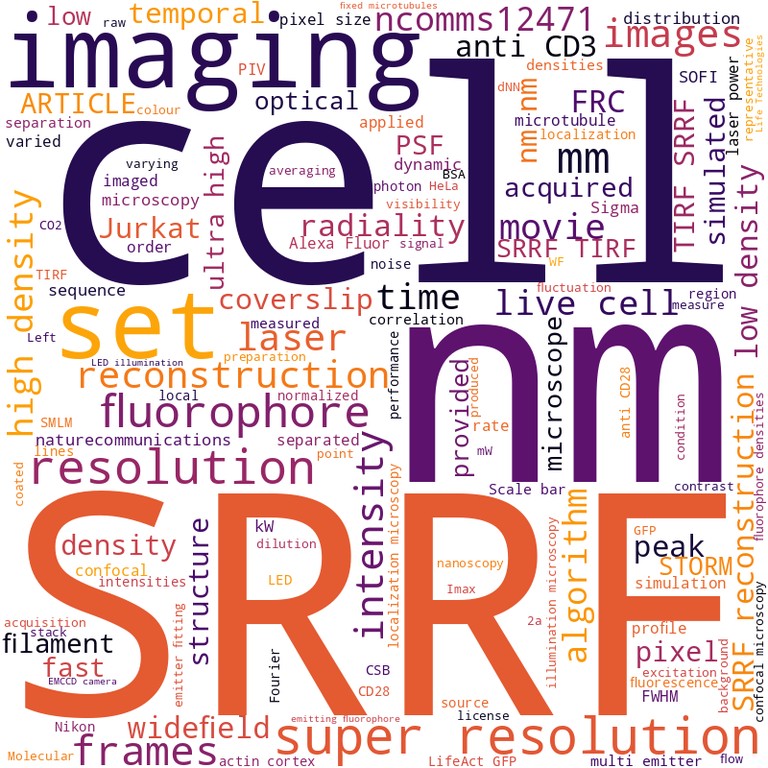
|
Fast live-cell conventional fluorophore nanoscopy with ImageJ through super-resolution radial fluctuations Nils Gustafsson, Siân Culley, George Ashdown, Dylan M. Owen, Pedro Matos Pereira, Ricardo Henriques Paper published in Nature Communications, August 2016 Technologies: NanoJ-SRRF () and QuickPALM Funded by: BBSRC News: Azom.com DOI: 10.1038/ncomms12471 |
|
Funding contributing to NanoJ-SRRF
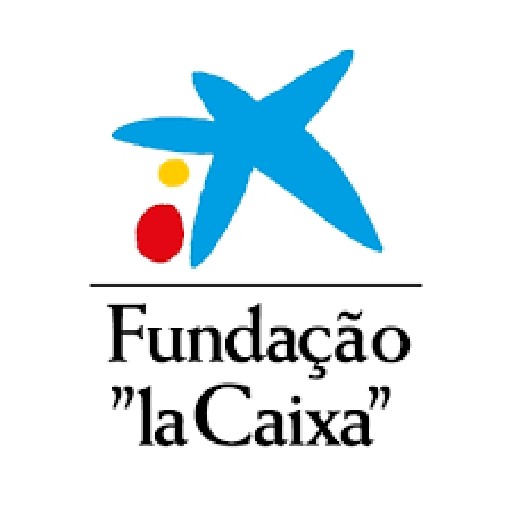
|
VirusAwareScopes - Machine Learning-Driven Adaptive Microscopy for Long-Term Viral Infection Studies Ricardo Henriques Alias: VirusAwareScopes Funded by: La Caixa Foundation - Health Research Duration: November 2025 - October 2028 |
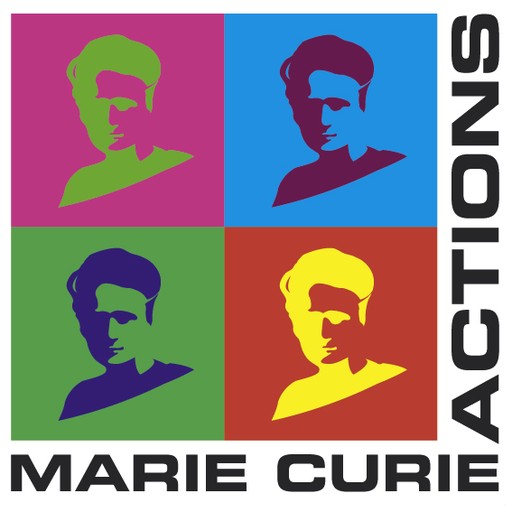
|
3D Nanoscope - a highly accessible, high-performance device for live cell nanoscopy Arturo G. Vesga Alias: 3DNanoScope4All Funded by: Marie Curie - HORIZON TMA MSCA Postdoctoral Fellowships Duration: March 2024 - February 2026 |
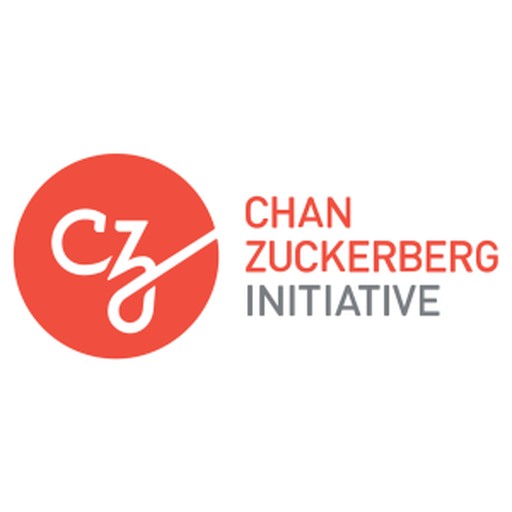
|
Sub-cellular Metabolic Compartmentalization During Oocyte Development Zita Carvalho dos Santos, Ricardo Henriques, Jorge Carvalho Funded by: CZI - Measuring Metabolism Across Scales Duration: January 2024 - December 2026 |
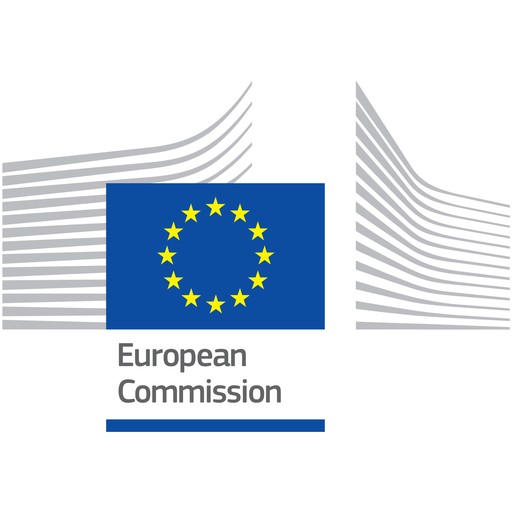
|
Real-Time high-content Super-Resolution Imaging of ES Cell States Eran Meshorer, Ricardo Henriques, Anna Kreshuk, Sandrine Lévêque-Fort, Nicolas Bourg, Genevieve Almouzni Alias: RT-SuperES Funded by: H2022 - EIC Pathfinder Open Duration: July 2023 - June 2027 Publications: 20 |

|
How does membrane topology influence T-cell activation and HIV infection? Simao Coelho Funded by: FCT - Exploratory Research Projects Duration: March 2023 - September 2024 |

|
Cutting-edge super-resolution image analysis in napari through NanoJ Bruno Saraiva, Ricardo Henriques Funded by: CZI - Applications - napari Plugin Foundations grants Duration: January 2023 - December 2023 Publications: 3 |

|
Artificial Intelligence for Image Data Analysis in the Life Sciences Anna Kreshuk, Florian Jug, Ricardo Henriques, Wei Ouyang, Arrate Muñoz-Barrutia, Emma Lundberg, Matthew Hartley Alias: AI4Life Funded by: H2021 - INFRA Duration: September 2022 - August 2025 Publications: 24 |

|
VP-CLEM-KIT - a pipeline for democratising volumetric visual proteomics Lucy Collinson, Ricardo Henriques, Paul French Funded by: CZI - Visual Proteomics Imaging Duration: December 2021 - June 2024 Publications: 21 |

|
Optial Biology PhD programme Michael Hausser, Ricardo Henriques, Antonella Riccio Funded by: Wellcome Trust - 4-year PhD Programme in Science Duration: August 2021 - August 2025 |
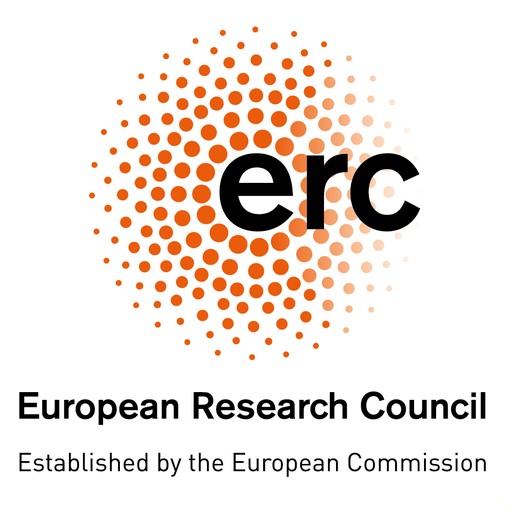
|
Enabling Live-Cell 4D Super-Resolution Microscopy Guided by Artificial Intelligence Ricardo Henriques Alias: SelfDriving4DSR Funded by: ERC - Consolidator Duration: July 2021 - June 2026 Publications: 36 |

|
Unveiling live-cell viral replication at the nanoscale Ricardo Henriques Funded by: EMBO - Installation Grant Duration: January 2021 - December 2025 Publications: 31 |